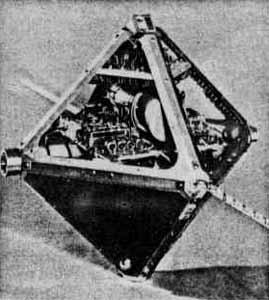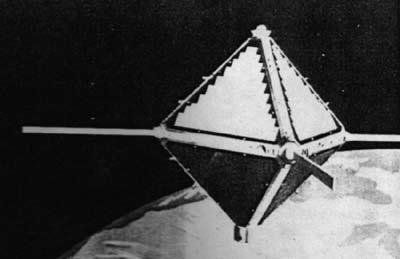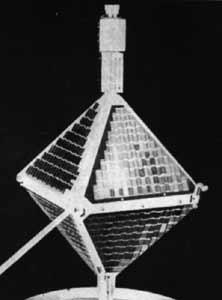Environmental Research Satellites (ERS)
From 1962 the US Air Force launched a series of Environmental Research Satellites (ERS). Depending on the shape, these satellites are also referred to as the Tetrahedial Research Satellite (TRS) or Octahedial Research Satellite (ORS). The objectives of the satellites varied.
| Name | Intl. Designation | Launch | Re-entry | Notes |
|---|---|---|---|---|
| ERS-1 | 1962 βπ1 | 11-Nov-1962 | 12-Nov-1962 | TRS failed to separate from Samos-11 |
| ERS-2 | 1962 αχ1 | 17-Sep-1962 | 19-Nov-1962 | Also known as Tetrahedron Research Satellite (TRS)-1; failed to separate from KH 4-12 |
| ERS-3 | --- | 17-Dec-1962 | --- | Failed to orbit |
| ERS-4 | --- | 17-Dec-1962 | --- | Failed to orbit |
| ERS-5 | 1963-014C | 9-May-1963 | Also known as TRS-2 | |
| ERS-6 | 1963-014D | 9-May-1963 | Also known as TRS-3 | |
| ERS-7 | --- | 12-Jun-1963 | --- | Failed to orbit |
| ERS-8 | --- | 12-Jun-1963 | --- | Failed to orbit |
| ERS-9 | 1963-030B | 19-Jul-1963 | Also known as TRS-4 | |
| ERS-10 | 1963-030A | 19-Jul-1963 | Failed to separate from Midas-9 | |
| ERS-11 | --- | --- | --- | Prototype which was not flown |
| ERS-12 | 1963-039B | 17-Oct-1963 | 5-Feb-1966 | Also known as TRS-5 |
| ERS-13 | 1964-040C | 17-Jul-1964 | ? | Also known as TRS-6 |
| ERS-14 | (No data) | |||
| ERS-15 | 1966-077C | 19-Aug-1966 | Also known as Octahedron Research Satellite (ORS)-1 | |
| ERS-16 | 1966-051C | 9-Jun-1966 | 12-Mar-1967 | Also known as ORS-2 |
| ERS-17 | 1965-058C | 20-Jul-1965 | ? | Also known as ORS-3 |
| ERS-18 | 1967-040C | 28-Apr-1967 | Also known as ORS-4 | |
| ERS-19 | (No data) | |||
| ERS-20 | 1967-040D | 28-Apr-1967 | Radiation studies; also known as OV5-3 | |
| ERS-21 | 1968-081C | 26-Sep-1968 | Radiation studies; also known as OV5-4 | |
| ERS-22 | (No data) | |||
| ERS-23 | (No data) | |||
| ERS-24 | (No data) | |||
| ERS-25 | (No data) | |||
| ERS-26 | 1969-046B | 23-May-1969 | Solar flare studies; also known as OV5-6 | |
| ERS-27 | 1967-040E | 28-Apr-1967 | Materials sciences research; also known as OV5-1 | |
| ERS-28 | 1968-081B | 26-Sep-1968 | 15-Feb-1971 | Radiation studies; also known as OV5-2 |
| ERS-29 | 1969-046A | 23-May-1969 | Radiation studies; also known as OV5-5 | |
| ERS-30 | 1967-123B | 13-Dec-1967 | 28-Apr-1968 | Also known as TTS-1 |
Launch dates of the ERS series
The ERS-1 or Tetrahedron Research Satellite (TRS), failed to separate from Samos-11 satellite from which it was to be deployed immediately after the launch. ERS-1 carried radiation instruments for the Vela Hotel series of satellites, which were to detect nuclear explosions in space.
The ERS-2, also known as TRS-1, carried a transmitter to study the changes in the Earth's radiation belt as a result of the Starfish high altitude nuclear test detonation over Johnston Island on 9 July 1962, as well as to study the effect of such radiation on solar cells. The 0.6 kg satellite failed to separate from the primary payload which was the KH 4-12 military reconnaissance satellite.
ERS-3 and -4 failed to achieve orbit due to launch vehicle failure, which also was to place the military Midas-6 satellite in orbit. ERS-3 was to conduct radiation and micrometeorite studies and carried a cosmic ray experiment as well as an infrared plume experiment. ERS-4 was to conduct similar studies.
ERS-5, also known as TRS-2, studied the radiation intensity of the Van Allen belts and the radiation damage to solar cells. The payload consisted of 132 solar and photovoltaic cells in various configurations. The mass of the satellite was 0.7 kg. ERS-6, also known as TRS-3, was identical to ERS-5 and was launched on the same launch vehicle.
ERS-7 and -8 were launched simultaneously and were to perform radiation and micrometeorite investigations but failed to orbit as the launch vehicle exploded shortly after launch.
ERS-9, also known as TRS-4, measured radiation damage to silicon solar cell samples. For this the satellite carried 132 n-on-p solar cells of which twenty were part of five experiment samples of four cells each, which included unshielded and shielded cells. There were also shielded and unshielded p-on-n solar cells. Data returned during the 11 days that information was collected, was correlated with data gathered by ERS-5 and ERS-6. The satellite's mass was 1.5 kg.
ERS-10 failed to separate from the primary payload which was the Midas-6 classified military satellite. It is believed ERS carried a payload similar to ERS-9.
The 2 kg ERS-12, also known as TRS-5, measured the intensity of charged particles in the magnetosphere. The payload consisted of an omni-directional radiation detector to measure electron levels greater than 0.5 and 5 Mev and proton levels between 10 and 20 Mev and 50 to 100 Mev. ERS-11 was a prototype that was never flown.
ERS-13, also known as TRS-6, also carried omni-directional radiation detectors to measure electron and proton levels in order to determine the intensity of charged particles in the magnetosphere.
The 5 kg ERS-15 (there was no ERS-14) used a new spacebus and was also known as Octahedron Research Satellite (ORS)-1. It carried out cold welding experiments using eight different material combinations which were fused using actuators.
The ERS-16 was a 15 kg scientific satellite was also known as ORS-2. The satellite carried a cold welding experiment consisting of five metal to metal tests using actuators.
ERS-17, also known as the ORS-3, monitored background radiation in the Van Allen belt. The 5.4 kg satellite carried five experiments to measure trapped radiation, cosmic rays, solar and galactic gamma rays and solar X rays. The satellite operated for 104 days.
 |
| Photo: Author's collection |
| ERS-17 (1965-058C) |
ERS-18, or ORS-4, continued the investigation of the Van Allen belts and carried six Geiger-Müller counters, low- and high-energy photomultiplier detectors, an X-ray detector, a solid state electron and proton detector and a surface barrier proton detector.
The 8.6 kg ERS-20 satellite (there is no data on ERS-19) conducted material studies to determine the effect of the space environment on metals. The satellite has also been referred to as Orbiting Vehicle (OV)5-3. The OV5 satellites were built by TRW and were octahedrons with sides of 28 cm each, or tetrahedrons. The payload consisted of sixteen small arms which swept across organic and inorganic material samples outside the satellite, to measure the friction and drag characteristics.
ERS-21 was also known as OV5-4. The 12 kg satellite obtained experimental data on the heat transfer in liquid under zero gravity conditions in support of the SNAP design of propellant systems. The test tank contained heating elements immersed in fluid freon and an expandable bellows externally pressurised with a fluid mixture to permit constant vapor pressure measurements. The fluid pressures and temperatures were measured at various points in the tank. The experiment failed prematurely.
 |
| Photo: Author's collection |
| ERS-21/OV5-4 (1968-081C) |
There is no data on ERS-22, -23, -24 and -25.
ERS-26, also known as OV5-6, was a 11 kg satellite to gather data for basic research on solar radiation. The payload consisted of: a solar flare monitor, six particle detectors, solid state detectors, a magnetic spectrometer, a Faraday cup and a fluxgate magnetometer.
The 6 kg ERS-27 conducted solar flare studies by measuring the X-radiation. Also known as OV5-1, the instrumentation consisted of a beryllium window proportional counter to measure X-rays from solar flares, solid state detectors to measure the background radiation, photomultipliers to measure the background radiation and six Geiger-Müller counters for X-ray measurements.
The 10 kg ERS-28 was also known as OV5-2 and was ejected from the launch vehicle during the early stages of the flight. The satellite conducted radiation studies by monitoring the electron and proton environments in the Van Allen belts. The instruments consisted of three sets of omni directional spectrometers, several Geiger-Müller tubes and directional detectors to measure electrons and protons.
ERS-29, also known as OV5-5, was a 11 kg satellite to gather data for basic research on solar radiation and its effect on the magnetosphere. Using a VLF plasma wave detector, an altitude sensor, a magnetometer and seven particle detectors, it measured the VLF proton and electron fluxes as well as the temporal variations of such fluxes. The combined payloads on this flight have also been referred to as S68-3.
ERS-30 was also known as the Test and Training Satellite (TTS)-1 or TETR-1. It provided testing and training facilities for tracking stations of the Manned Spaceflight Network and with the unified S-band transmitter used on the Apollo spacecraft. This transmitter operated at 2101.9 MHz and 2283.5 MHz.
 |
| Photo: Author's collection |
| ERS-30 (1967-123B) |
Back to Directory of U.S. Military Rockets and Missiles, Appendix 3
Last Updated: 12 April 2005